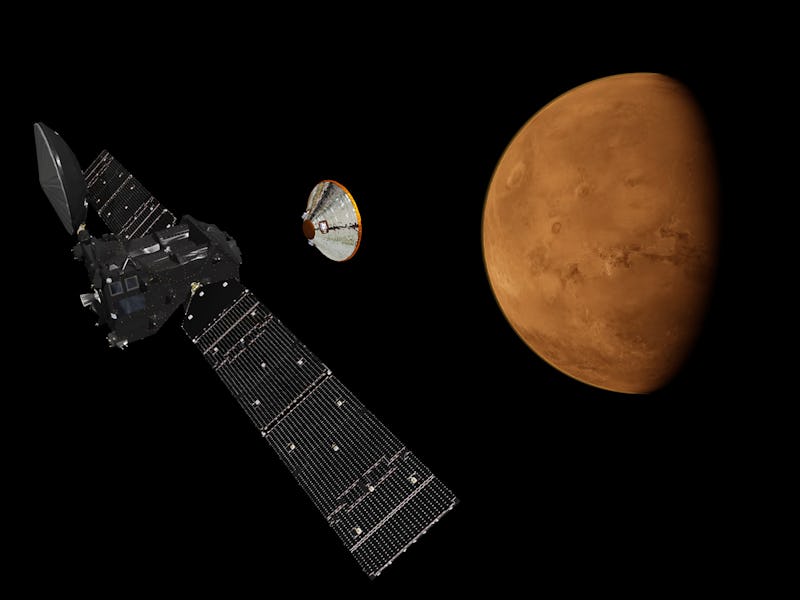The fate of the European Space Agency’s (ESA) ExoMars mission hangs in the balance. ESA officials are nervously waiting to learn whether the mission’s Schiaparelli lander safely made its way to the surface of Mars, experienced a fatal crash, or something else entirely.
The Schiaparelli lander — part of a joint mission by the European and Russian space agencies — split from its orbiting counterpart, the Trace Gas Orbiter (TGO) on October 16, to prepare for landing. It’s prime directive: to test entry, descent, and landing (aka EDL) technologies that the duo will use to send Schiaparelli’s life-hunting successor to the Red Planet in 2021.
TGO successfully inserted itself into Martian orbit. Unfortunately, 218 days after the initial launch of ExoMars, ESA has no idea whether Schiaparelli has accomplished its own goal to safely plop down on the Red Planet’s surface.
Landing on Mars is no easy feat. To date, only seven spacecrafts have successfully landed on Mars — and all seven belong to NASA. In order to pull off a successful landing, engineers programmed the lander with a series of braking maneuvers, much like the ones Curiosity used in 2012.
There was only one shot at this, so the high-speed, choreographed approach has to be done just right. If not, the spacecraft could crash into the planet’s surface. During its six-minute trip through the thin Martian atmosphere, Schiaparelli was subjected to one heck of a ride.
Barreling towards the surface at nearly 13,000 miles per hour, Schiaparelli’s fate rested on a heat shield, and parachutes to slow itself from 13,000 miles per hour to about 150 miles per hour, before a set of thrusters would fire, allowing the craft to touch down in tact.
Although Schiaparelli’s main job is to test out technology for future missions, the craft (if it survived the landing) will also conduct a bit of science. It’s the height of dust-storm season on Mars, and while there are no signs of an impending storm, NASA warned we could see a rare global storm in the coming weeks.
As long as Schiaparelli’s batteries last, the saucer-shaped lander will be gathering and analyzing data on these types of storms. While dust storms on Mars are not like their cinematic counterparts (like the one depicted in the Martian), they can be a nuisance. Dust storms generate electric fields, and scientists are particularly interested in trying to measure the amount of energy produced to gauge the effects storms will have on communications and other electronic equipment. By measuring wind speed, humidity, pressure, and temperature, scientists are hoping to learn how these dusty tempests form.
ESA equipped Schiaparelli with an ultra-high frequency (UHF) radio so it can transmit data directly to ESA, and also to a fleet of spacecraft orbiting Mars. ESA expected to hear from Schiaparelli directly after it touched down on Mars, but that didn’t happen. The signal never came.
The space agency turned to the Mars Express orbiter for help, but it could not confirm Schiaparelli’s signal. The attempt to make contact with the lander will be with NASA’s Mars Reconnaissance Orbiter as it flies over Schiaparelli’s landing site between 12:49 p.m. Eastern and 1:03 p.m. Eastern. The satellite will downlink any potential signals roughly an hour later.
Even if Schiaparelli experienced a fatal descent, the ExoMars mission is not a total loss. Despite the lander’s current radio silence, TGO — which acts as Schiaparelli’s mothership — checked in as planned at 12:34 p.m. Eastern.
Nevertheless, if Schiaparelli is confirmed to be lost, it could be a major blow to ESA’s future plans to investigate Mars.
